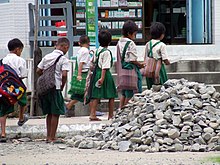Learning modalities
There has been much interest in learning modalities and styles over the last two decades. The most commonly employed learning modalities are:[40]- Visual: learning based on observation and seeing what is being learned.
- Auditory: learning based on listening to instructions/information.
- Kinesthetic: learning based on movement, e.g. hands-on work and engaging in activities.
Dunn and Dunn[41] focused on identifying relevant stimuli that may influence learning and manipulating the school environment, at about the same time as Joseph Renzulli[42] recommended varying teaching strategies. Howard Gardner[43] identified a wide range of modalities in his Multiple Intelligences theories. The Myers-Briggs Type Indicator and Keirsey Temperament Sorter, based on the works of Jung,[44] focus on understanding how people's personality affects the way they interact personally, and how this affects the way individuals respond to each other within the learning environment. The work of David Kolb and Anthony Gregorc's Type Delineator[45] follows a similar but more simplified approach.
Some theories propose that all individuals benefit from a variety of learning modalities, while others suggest that individuals may have preferred learning styles, learning more easily through visual or kinesthetic experiences.[46] A consequence of the latter theory is that effective teaching should present a variety of teaching methods which cover all three learning modalities so that different students have equal opportunities to learn in a way that is effective for them.[47] Guy Claxton has questioned the extent that learning styles such as VAK are helpful, particularly as they can have a tendency to label children and therefore restrict learning.[48][49] Recent research has argued "there is no adequate evidence base to justify incorporating learning styles assessments into general educational practice."[50]
Philosophy

John Locke's work Some Thoughts Concerning Education was written in 1693 and still reflects traditional education priorities in the Western world.
Main article: Philosophy of education
As an academic field, philosophy of education is "the philosophical
study of education and its problems (...) its central subject matter is
education, and its methods are those of philosophy".[51]
"The philosophy of education may be either the philosophy of the
process of education or the philosophy of the discipline of education.
That is, it may be part of the discipline in the sense of being
concerned with the aims, forms, methods, or results of the process of
educating or being educated; or it may be metadisciplinary in the sense
of being concerned with the concepts, aims, and methods of the
discipline."[52] As such, it is both part of the field of education and a field of applied philosophy, drawing from fields of metaphysics, epistemology, axiology and the philosophical approaches (speculative, prescriptive, and/or analytic) to address questions in and about pedagogy, education policy, and curriculum, as well as the process of learning, to name a few.[53]
For example, it might study what constitutes upbringing and education,
the values and norms revealed through upbringing and educational
practices, the limits and legitimization of education as an academic
discipline, and the relation between education theory and practice.Curriculum
In formal education, a curriculum is the set of courses and their content offered at a school or university. As an idea, curriculum stems from the Latin word for race course, referring to the course of deeds and experiences through which children grow to become mature adults. A curriculum is prescriptive, and is based on a more general syllabus which merely specifies what topics must be understood and to what level to achieve a particular grade or standard.An academic discipline is a branch of knowledge which is formally taught, either at the university–or via some other such method. Each discipline usually has several sub-disciplines or branches, and distinguishing lines are often both arbitrary and ambiguous. Examples of broad areas of academic disciplines include the natural sciences, mathematics, computer science, social sciences, humanities and applied sciences.[54]
Educational institutions may incorporate fine arts as part of K-12 grade curricula or within majors at colleges and universities as electives. The various types of fine arts are music, dance, and theater.[55]
Instruction
Instruction is the facilitation of another's learning. Instructors in primary and secondary institutions are often called teachers, and they direct the education of students and might draw on many subjects like reading, writing, mathematics, science and history. Instructors in post-secondary institutions might be called teachers, instructors, or professors, depending on the type of institution; and they primarily teach only their specific discipline. Studies from the United States suggest that the quality of teachers is the single most important factor affecting student performance, and that countries which score highly on international tests have multiple policies in place to ensure that the teachers they employ are as effective as possible.[56][57] With the passing of NCLB in the United States (No Child Left Behind), teachers must be highly qualified. A popular way to gauge teaching performance is to use student evaluations of teachers (SETS), but these evaluations have been criticized for being counterproductive to learning and inaccurate due to student bias.[38]Economics
Main article: Economics of education
At the level of the individual, there is a large literature, generally related to the work of Jacob Mincer,[61] on how earnings are related to the schooling and other human capital. This work has motivated a large number of studies, but is also controversial. The chief controversies revolve around how to interpret the impact of schooling.[62][63] Some students who have indicated a high potential for learning, by testing with a high intelligence quotient, may not achieve their full academic potential, due to financial difficulties.[citation needed]
Economists Samuel Bowles and Herbert Gintis argued in 1976 that there was a fundamental conflict in American schooling between the egalitarian goal of democratic participation and the inequalities implied by the continued profitability of capitalist production on the other.[64]

No comments:
Post a Comment